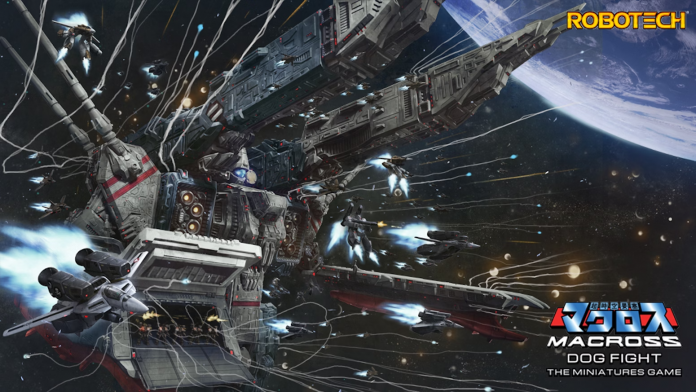Mechahammer week continues here on Goonhammer and we’re talking about more mech-infested games. This time looking at the Robotech Macross Dogfight Miniatures game.
So what is Macross?
Macross is a Japanese animated series that started in 1982 with Super Dimension Fortress Macross. This popularised transforming mecha, and Shōji Kawamori, who created Macross, also created the Diaclone toy line which provided a significant number of the Generation 1 Transformers. Macross ended up being hugely influential.
I’m not going to recount the history of Macross here, when I could pretty much cover it in a gif.
However at the time most Japanese media and toylines were divided in terms of licensing/distribution into Japan and the less lucrative ‘rest of the world’. This led to Harmony Gold purchasing Super Dimension Fortress Macross and two other unrelated anime series and dubbing them into a combined series known as Robotech, as a minimum number of episodes was required for syndication in the US, and the Macross series only had 36.
This became a huge source of controversy as Harmony Gold took a series of legal actions against other parties for mecha involved properties, including the creators of Battletech who licensed a number of mecha designs including some from Macross, as well as asserting that Harmony Gold had worldwide distribution rights for Macross merchandise.
Harmony Gold had several cases dismissed with prejudice, and was involved in the Mediaset and Mediatrade trials that came about during the investigations into Silvio Berlusconi and associates for tax fraud, embezzlement and false accounting. These legal cases have now been settled or dismissed and Harmony Gold has reached an agreement that allows the distribution of Macross merchandise outside of Japan. The continued involvement of Harmony Gold is controversial for Macross fans.
This licencing still divides distribution into Japan and the rest of the world, and is the reason why the Robotech name appeared on both the Palladium and Kids Logic games, as Harmony Gold sold the licence to them for the game rather than Studio Nue, the creator of Macross, though the licence is now ‘harmonised’ to some extent and Macross appears on the Kids Logic box.
This licencing situation has meant that Harmony Gold want to push Robotech as an intellectual property, whereas all the new Studio Nue content (Macross Plus, Macross 7, Macross Frontier and Macross Delta) is consistent with Macross and thus completely divergent from Robotech, which is as understandable as Disney not conforming the new Star Wars films to what’s on Wookiepedia. This means that a company wanting to do tie-ins is in an invidious position where to sell anything outside of Japan they need a licence from Harmony Gold, and historically weren’t able to include any developments after 1986 (and thus can’t include a ton of cool stuff). This may change with the new licensing structure but time will tell. This is very clearly illustrated with video game tie-ins, which all have to be grey imported for the rest of the world and aren’t available on things like Steam.
Previous Macross Games
Japanese Games
Prior to the involvement of Harmony Gold, there were several Macross board wargames. These were published by Tsukuda Hobby in 1983 and 84, and consisted of Macross Dog Fight, Macross Space Fold, Macross VF-1 Valkyrie and Macross City Fight. A somewhat less complicated game was published by Bandai called Macross: Love is Passing Away. As with most board wargames out of print for over forty years that were never published outside of Japan, these are fairly hard to get. There is an english translation of the City Fight rules, but this is a fan translation I believe.
Robotech Games
A series of Robotech board games have been published through licencing from Harmony Gold, but the elephant in the room when discussing Robotech games is Robotech RPG Tactics by Palladium. I know even mentioning it will have a number of people reading this article wincing.
Robotech RPG tactics was a kickstarted game by Palladium that promised plastic figures and turned out in such a way that if I were to write a detailed breakdown of how it went I’d be writing several thousand words and getting it checked by legal before publishing. Needless to say it did not go well and after Palladium having the Robotech licence for about thirty years, it was not renewed.
You can still find some RPG Tactics miniatures for sale, often discounted. The sprue layout of these minis has been heavily criticised, and the 1/285 scale minis were 20-30 pieces each (insert another wince here), leading to people having difficulty assembling them and the miniatures being fragile when handled.
Robotech Macross Dogfight
Kids Logic acquired the Robotech license in 2019 and started to produce statues and wargaming scale miniatures. They produced a boxed game, Robotech Macross DOG FIGHT- The Miniatures Game, in March 2021. In May 2022 they launched a Kickstarter to produce more miniatures and an expanded boxed set, and were successfully funded to produce a significant number of miniatures and a larger boxed game.
Since then the Kickstarter, due to deliver in December 2022, has experienced some delays and communication issues, but some of this can be explained by the disruption caused by Covid in China in late 2022 and early 2023. While Kids Logic are not particularly good at communicating (last update was for Lunar New Year, saying production on a number of miniatures was commencing and the ‘space’ rules would be uploaded within a month, though this has not happened) it looks like the kickstarter is delayed, not dead.
With small companies and kickstarters, issues and delays are literally part of the experience, and they are showing progress is being made, they’re just not good at communication on their Kickstarter and Facebook page.
Kids Logic have said that a new version of the rules, the ‘space’ version, will be released with the Kickstarter. I have not seen this version of the rules, which may fix all the criticisms that I have regarding the game, and when they are released I may reconsider my opinions and write a review specifically of the ‘space’ rules if I feel it warranted.
The Game
To people who have played Wings of War or Aeronautica Imperialis 1st Edition, the movement mechanics will be very familiar. X-wing and Star Trek Attack Wing use similar movement mechanics, but in only two dimensions, which make them significantly simpler. Dogfight has three levels of altitude (as oppose to Aeronautica 1st Edition with nine) but the level you are at changes the damage you do for the three weapon types, and the change is different for each weapon type.
Movement is handled by models sitting on small square stands, and movement uses secret pre-plotted simultaneous movement using movement tools that correspond to the speed and direction chosen on the control panels for each model.

However you can also move sideways and backwards, and so in the ring of movement options you can choose there is an inner ring, and if you want to select one of these options there is a small arrow indicator that you can turn to indicate that you have made that choice.
When movement takes place, the paths models take can intersect and this causes a ‘crossover event’. Each player draws a card from a crossover event deck, of which there is one per player, and this is treated as a ‘head to head combat’.
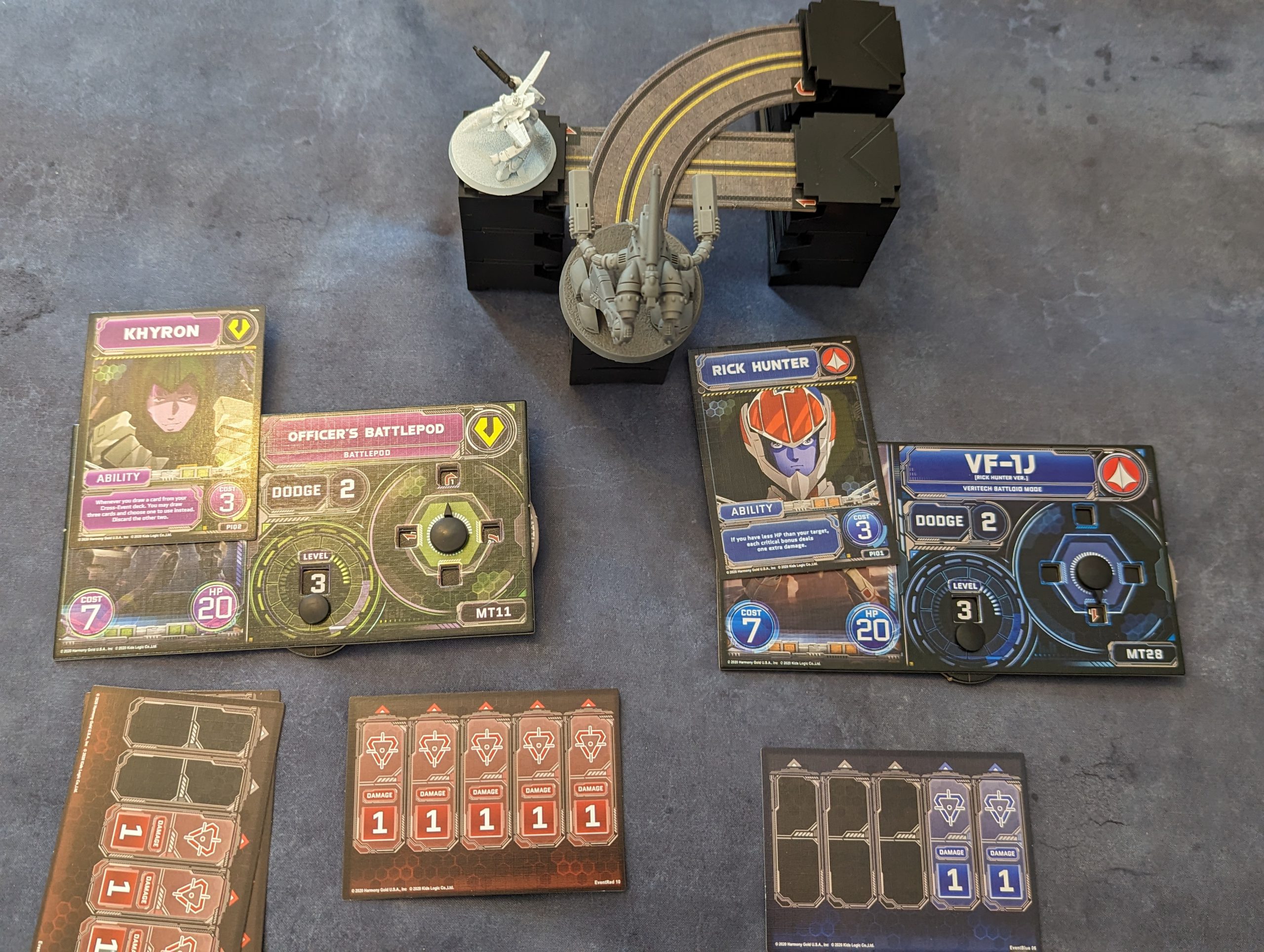
Combat is resolved dicelessly, using two combat trays where players put in three ammunition counters and a token for the direction and amount of dodging they are doing. If you do not have your opponent in arc then you can only dodge. This means that in non-head to head combat against a model with a Dodge of 2 you can always guarantee two hits by putting a 2 Ammo counter in the central slot, and you have a 50/50 chance of three hits depending on the direction your opponent chooses to Dodge.
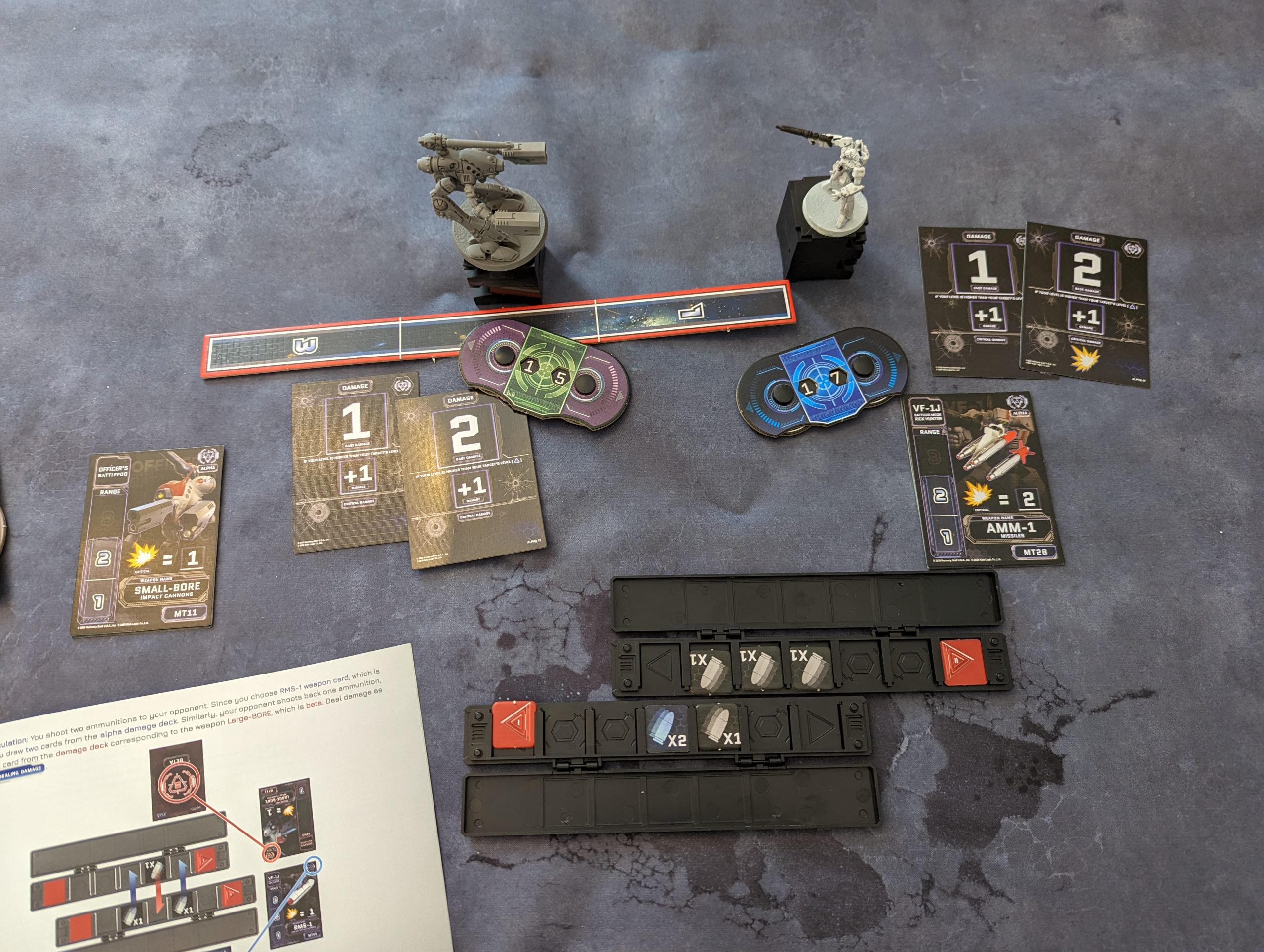
Prior to the release of the Kickstarter, there are only two units that can be used in the game, the Zentradi Officer’s Battlepod and the UNSPACY VF-1J. This limits the playability of the game significantly, especially as there is only one pilot per faction available.
The Good
All the mechanics in the game are reasonably well thought out and range from workable to good. There are some caveats I will discuss in the next section.
The art is good, and there is a lot of value in the components. I’ll discuss the drawbacks of this in the next section.
As a 1-v-1 or 2-v-2 game, this is actually pretty decent fighter skirmish game. I would not necessarily say for Macross, but it may be better at representing Macross Delta or Frontier era craft where craft have pinpoint barriers seen only on capital ships in the original series and where fighters are significantly more survivable. However this game is for original Macross, where everything dies in droves.
The miniatures are good enough that I’ve given them their own section below.
The Bad
The game as a whole works, and every mechanic in it works (though some could be better explained in the rules) but the issue is their combination. It’s just a complicated game with a lot of steps.
The damage system is overly complicated, with three damage decks with slightly different outcomes, and these are modified by the relative altitudes of the craft firing at each other, with the three different damage decks gaining an advantage for being a level above, the same level or the level below. This tends to lead to models gaining levels as they close, as the best damage deck is the one for being above your opponent, but this is also the deck for weapons with the lower ranges.
The units in the basic starter set have 20 hit points each, which means generally they need to get good hits in on each other on at least three or four times to destroy each other. This gives long games.
This is my key criticism of the game. Compared to Aeronautica or X-wing units last a long time. This means, combined with the complexity of all the mechanics, that the game is unsuitable for playing with a large number of units, which is what you want to do with a Macross game, particularly one which is representing a series where battles weren’t 1 vs 1 skirmishes normally, but squadron actions.
I would go so far as to say that there is definitely ludonarrative dissonance between the game as it is written and what it is meant to represent. You can’t do a Macross missile swarm. All weapons have 3 ammo for the point of resolving the damage mechanics, while there is design space for variation here to represent different weapons (so missile swarms vs beam weapons would allow you to give say micro missiles 5 or 6 ammo while causing less damage than say a 1 ammo beam weapon with 1 shot but causing a lot of damage).
This game loves cards and printed material, and I’ll come to this talking about product design.
This is a game of attrition, which is overly complicated and can’t be played at scale.
The Miniatures
The miniatures are all resin, and there appears to be two distinct types, a slightly softer resin seen in the Rick Hunter Valkyrie various modes, and the type seen in the models like the Destroids, Skull Squadron Battloid and some of the Zentradi. There also appears to be an intermediate, less soft version of the first resin, though this may be caused by improved sculpting and casting.
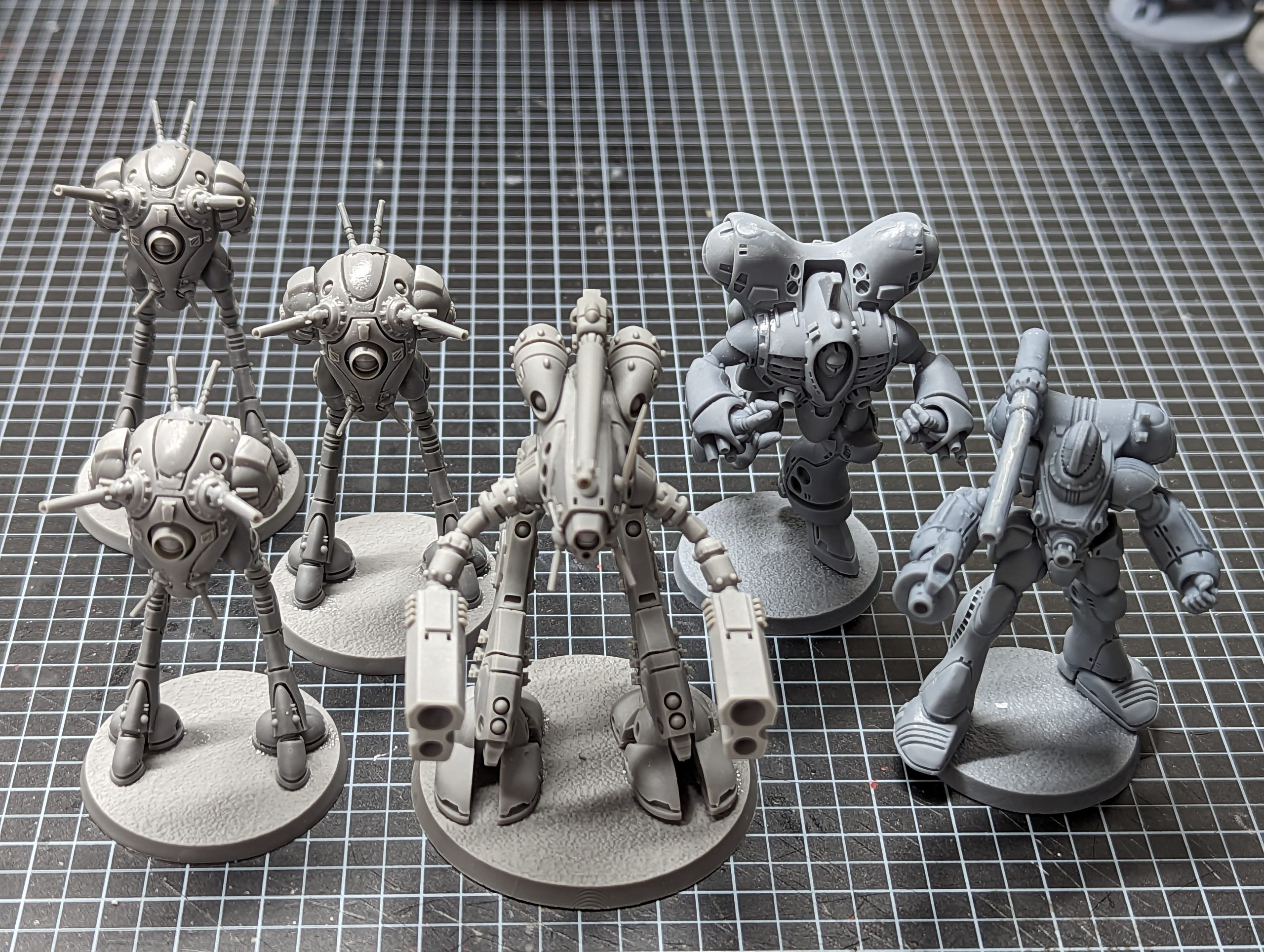
The scale is 1/285, but the models are rescaled compared to the Palladium ones, and appear more in line with the series (though in particular the original Macross series had some animation errors regarding scale that’s led to a lot of discussion about things like how tall a Zentradi is).
When cleaning, assembling, handling and painting these models you have to remember that some of them have some very delicate, small and thin pieces. Comparing MT 17 (the VF-1S Veritech) to MT28 (the VF-1J Veritech) you can clearly see the fins on the legs have been thickened (it looks like they’re twice as thick, though I haven’t checked with a micrometer) which makes them substantially more robust. If this was a deliberate decision by Kids Logic, it was the correct one.
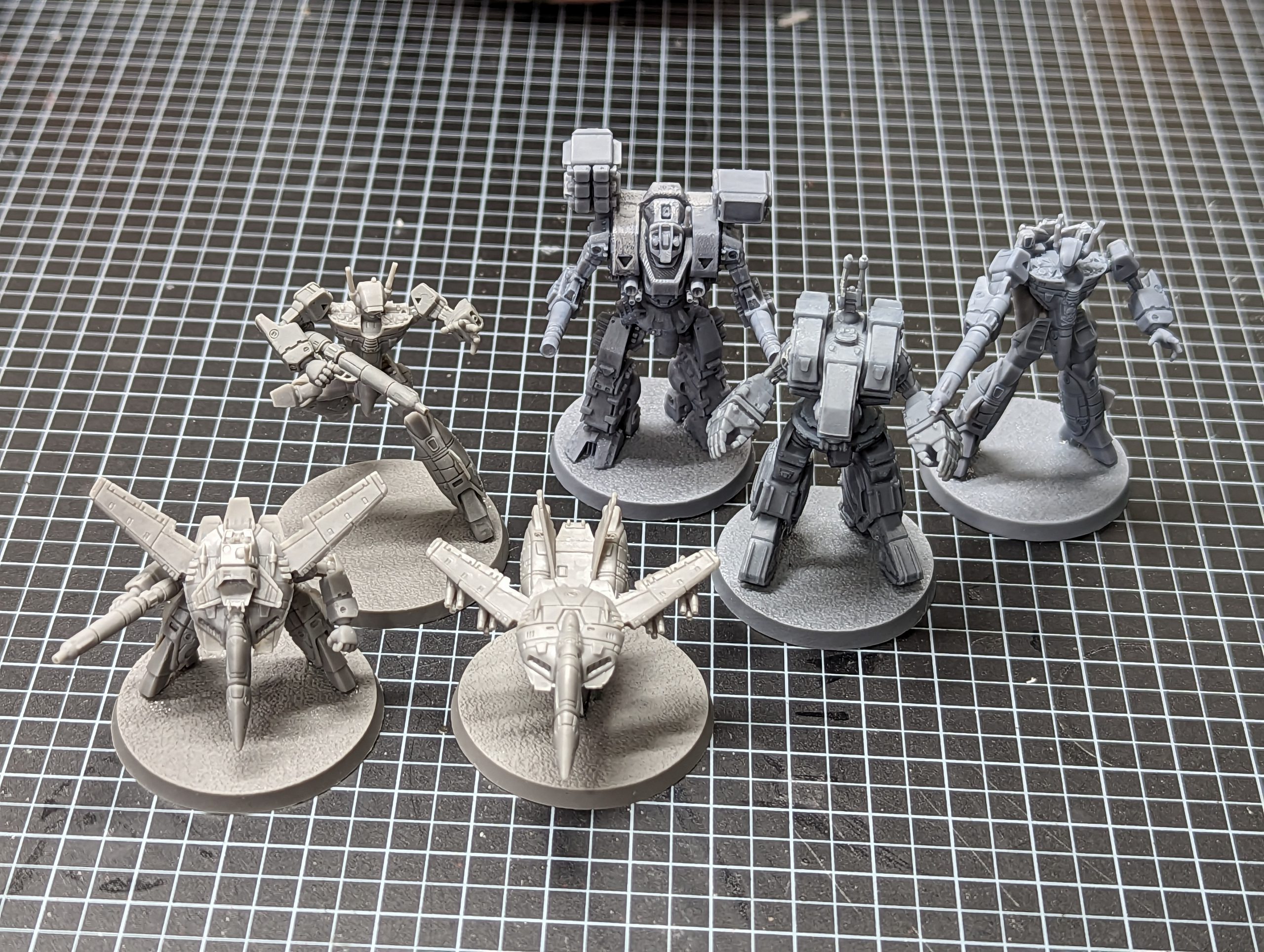
The kits are well packed, as they feature some very delicate pieces, and whether the blisters or the game box, they are packed with foam, see the examples below.
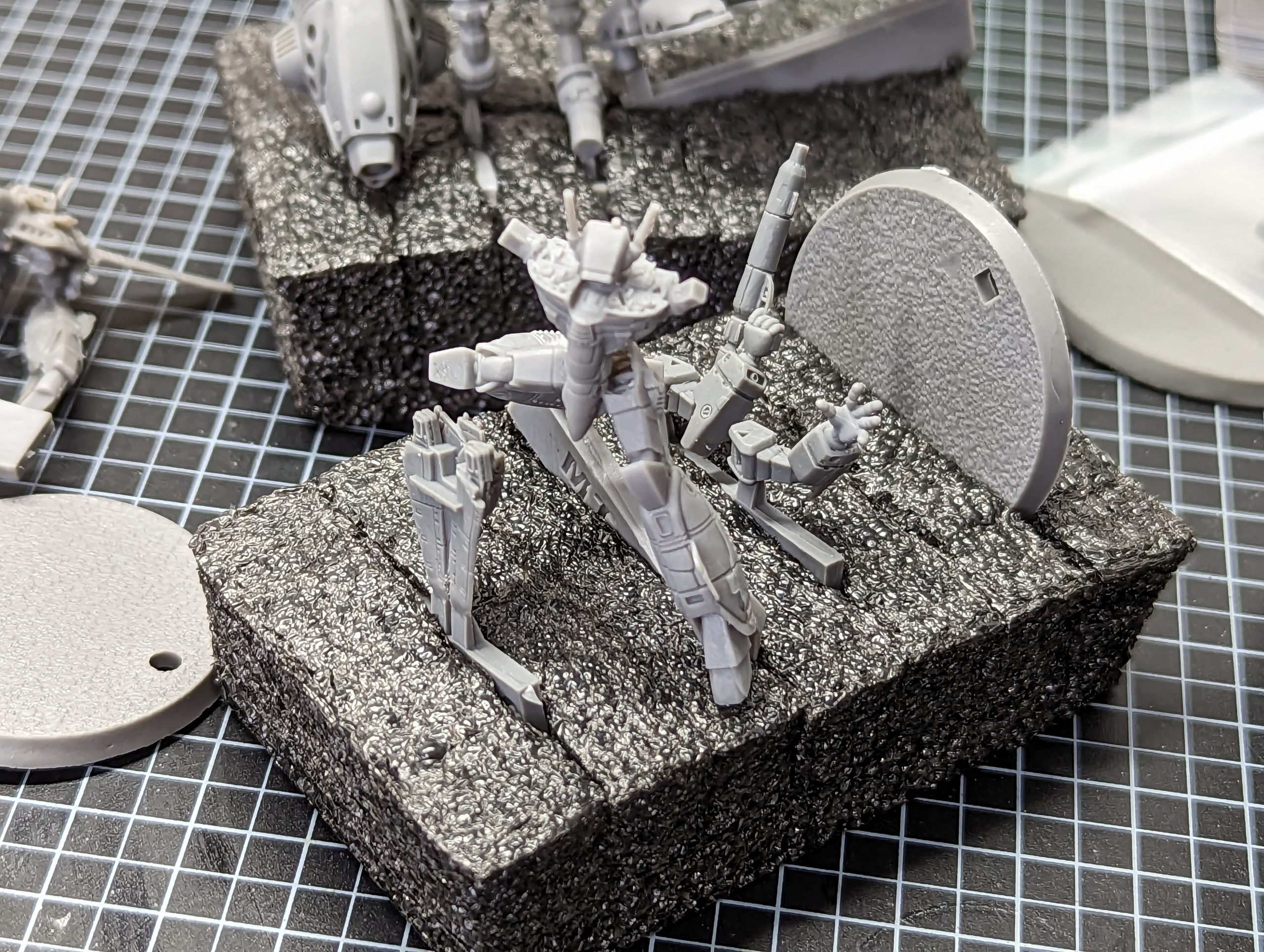
As they are resin miniatures I washed them all in soapy water to remove any mould release.
I’ve assembled the Regults below, and painted them in the Macross/Robotech series scheme.
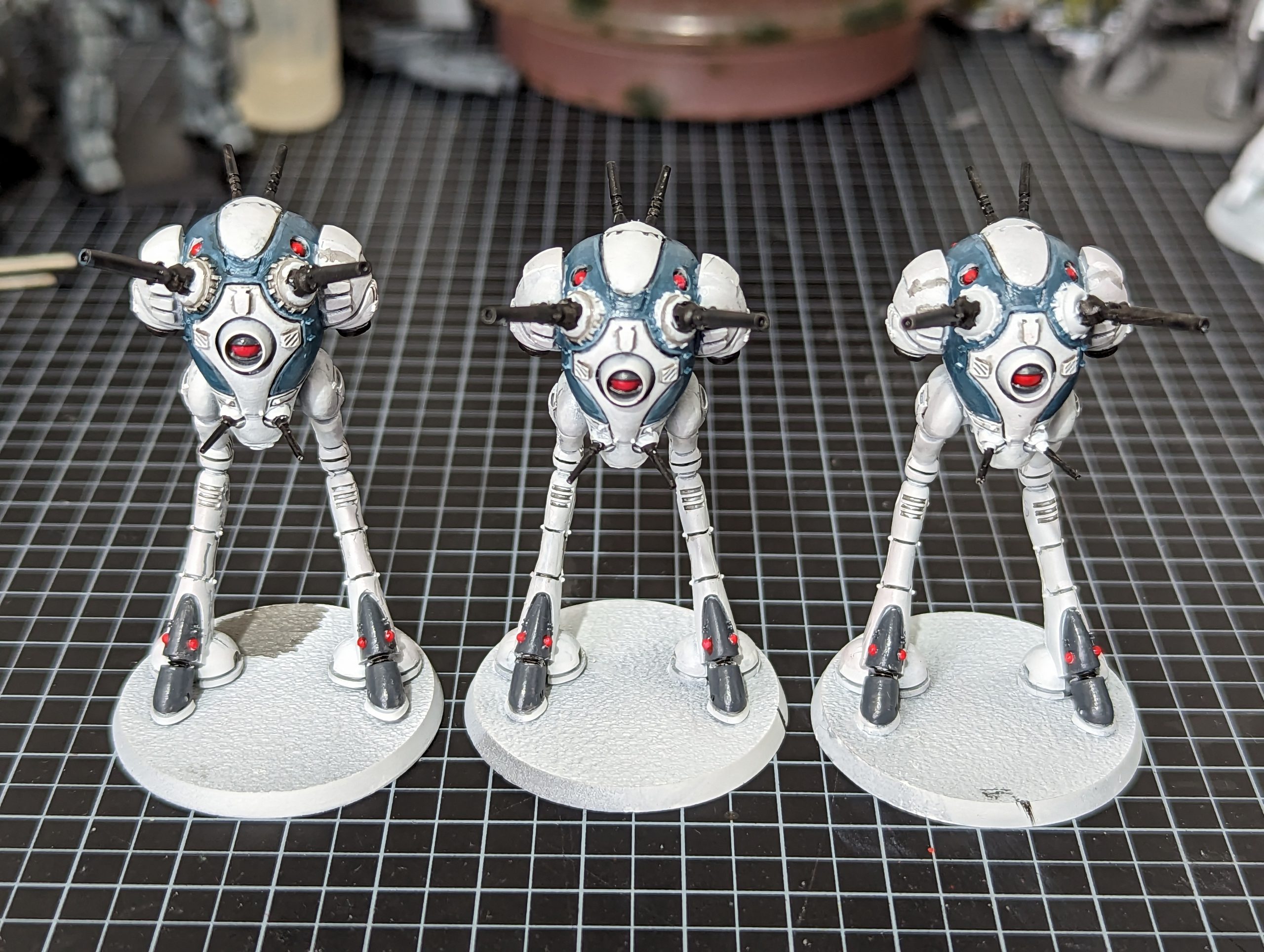
Assembly was fine, though there are mould lines/slips on the legs that need very careful treatment given the amount of leg detail. The smaller guns are incredibly small, and the pilot hatch on the back similarly needs careful. The cartoon scheme painted up quick, with only a few colours used and the detail easily accented with some panel lining.
For comparison to say, Battletech miniatures, here they are.
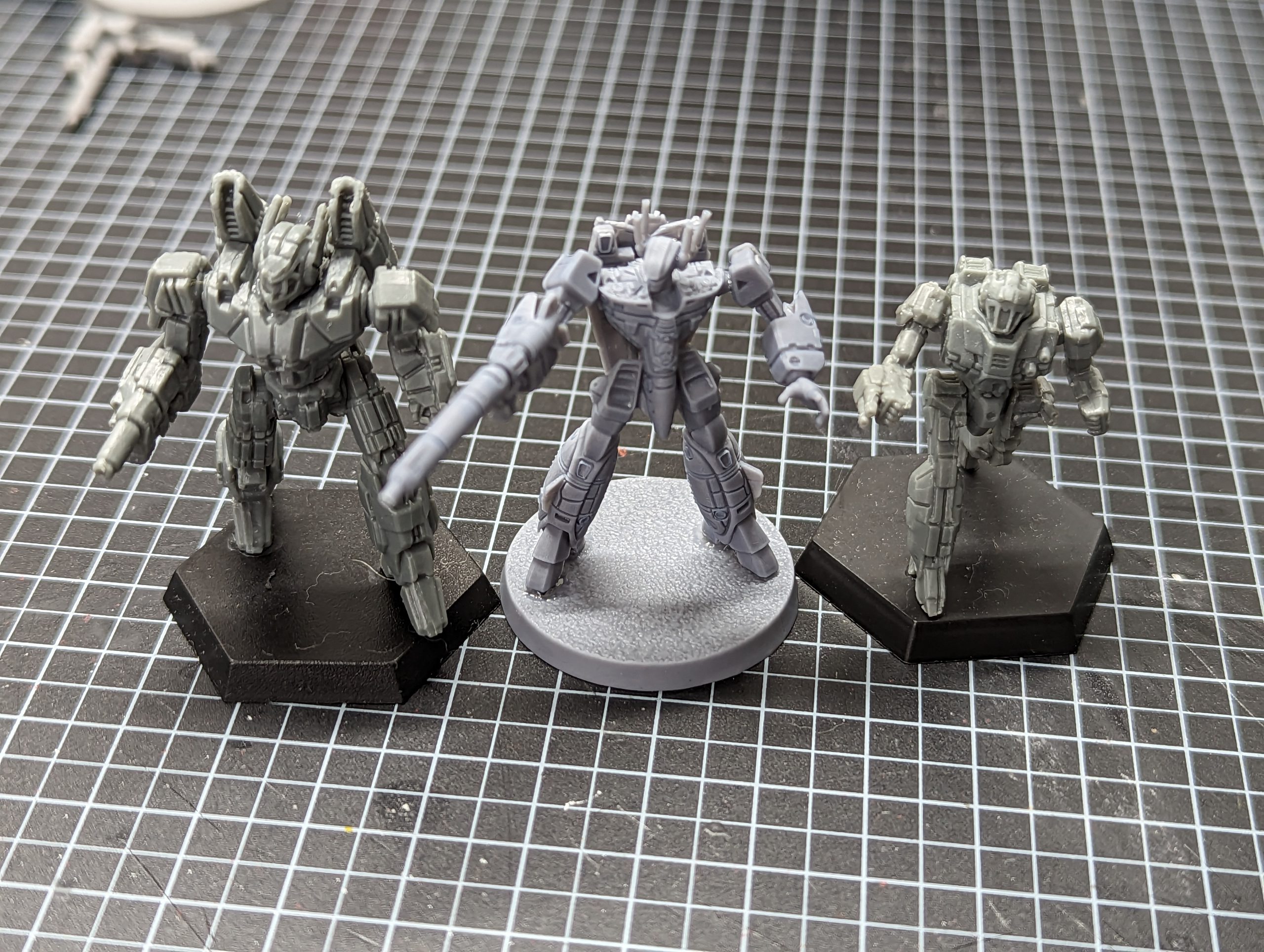
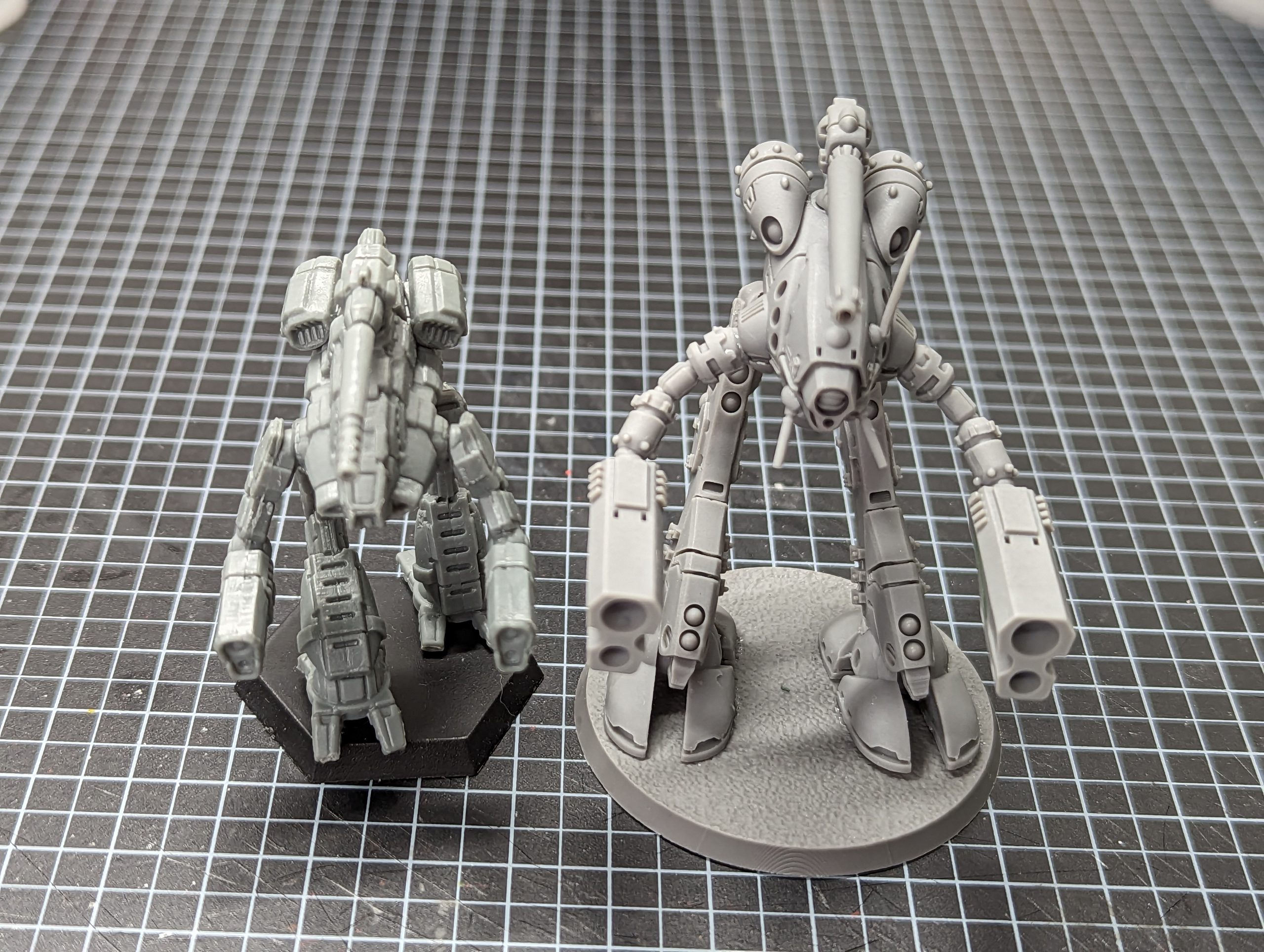
Why Product Design is Important
When you are designing a wargames product, you need to bear in mind one key principle – you want to actually sell games. This is where, as a product designer, you need to make a lot of decisions to have a saleable product.
There are three major elements in game design – gameplay, mechanics and player experience. I feel there are problems with all of these elements in this game.
Robotech Macross DOG FIGHT- The Miniatures Game is very interesting from a product design perspective, because the problems with the game I feel are baked into it from the very start.
The game is mechanically complex
The rules are not that long, and in places not that well explained, but they are complicated. The game is diceless, and in order to allow for variation in damage, has three different damage decks of ten cards each, two crossover event decks of ten cards each, and weapon cards for the multiple weapon systems each craft has. This means there are five decks to draw from to resolve events, and over 70 playing card sized cards. The movement system is 3-dimensional and complex, and when playing the game itself it is fiddly.
The game cannot be played at scale.
Three or possibly four miniatures per side would be a long and grueling game because of the complexity of the mechanics and the amount of damage a craft has to take to destroy it. The most profitable element of miniature wargaming is the miniatures, and limiting the size of games that can be played limits the miniatures that customers will purchase.
This contributes to issues with……
Faithfulness to the feel of the source material.
The original Macross series featured a lot of large scale engagements and squadron level actions. Even the more limited battles sometimes seen (the Max vs Milia battle in Do You Remember Love, initially started as a flight of Valkyries vs several Meltrandi pilots) didn’t drag out. In this game all units last for multiple turns even with the most damaging hits you can muster in the system, it’s not really reflective of how battles work in Macross.
The individual duels of Macross Delta would feel better with this system, but the way that the licensing is done there is very little chance of that happening.
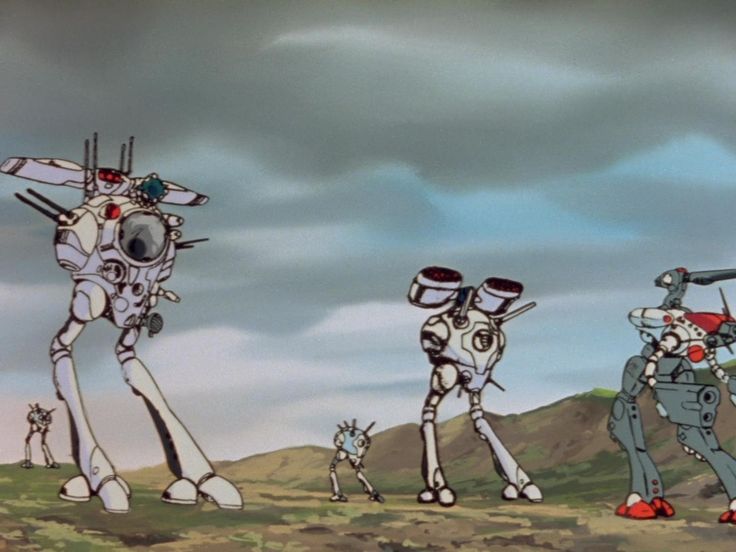
When you are adapting an intellectual property to a wargame or board game, then you need to reflect in each step how the original property feels. The adaptations of Hellboy by Mantic Games are a good example of this, and the various reskins of base building games for different IPs are a bad example of this. The game doesn’t feel like Macross to me, and that’s a cardinal sin in a game that only has it’s IP going for it.
Failure to tell stories
There are no scenarios included with the basic set, and it comes across almost as a proof of concept rather than a starter set. There are no scenarios, no guide to victory conditions, and creating this is left entirely to the player without guidance. You can read a lot more about emotional outcomes in games in this article, but I would say the failure to feel like Macross and give you stakes and scenarios is a big problem.
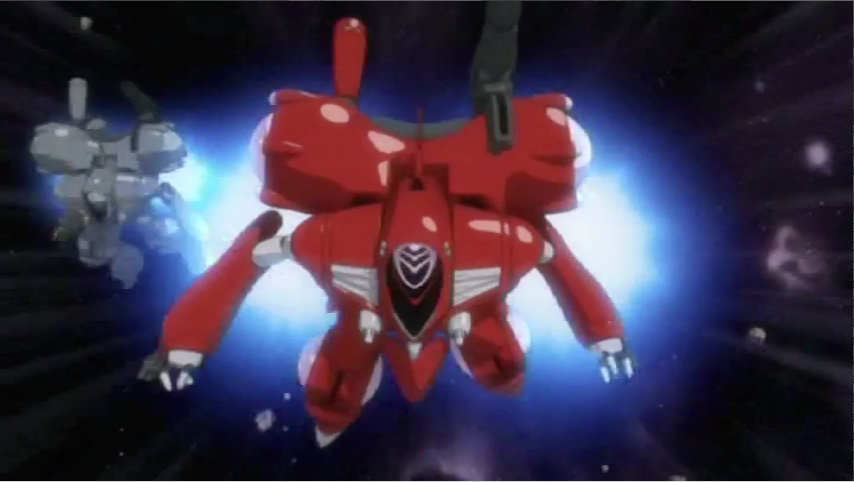
The picture above is from Macross Frontier, and from a training battle that would make a pretty perfect scenario.
Failing to kill the sacred cows
This is a game written by clever people, taking inspiration from successful games.
But part of game design, when you’ve got all your great ideas down, is to pare them down to a minimum viable product and think like a player. This is what this game desperately needed. It’s cleverly complex, but players need cleverly simple (this is going to be the major theme of the changes to 10th edition 40k for example).
The designers did not want to use dice. This committed them to alternative mechanics to introduce chance into the game, in this case a variety of card decks. The games that Dogfight takes inspiration from all use dice for a reason, even if they insist on custom dice (curse you FFG!). Dice introduce the factor of random chance, can’t be counted like cards can, and don’t limit you to one of each result in the way that drawing cards from a deck does. Randomness is discussed at length here, so I won’t inflict too much more discussion of it on you now.
Design choices have been made to use a lot of card stock. In 2020/2021 this was less of a bad decision than it is now, though for a company based in China it’s less of a risk than for a US or UK based company with at least a 5 month lead time for printed material of certain types (as there just aren’t the printing options in countries like the UK that there were twenty years ago). Is it better to have 50 cards in five different decks to resolve damage, or just put some dice in? From a design perspective which is logistically easier, with significantly lower lead times, and much easier to replace damaged or lost components? It’s dice. The answer is dice.
When you release a game, you want to give it momentum through continued support and releases. The basic game was released in 2021, with no further releases since then. This means any players they gained with the initial release have gone two years with no variety in the game and only one single unit and pilot per side being available.
This means people who want to play the game have no reason to purchase additional miniatures, there is no variety available for players, and the mechanics are so complex (with the movement dials in particular) that it ties the game to being expanded with printed cardstock that can’t really be distributed over the internet. In comparison Aeronautica Imperialis 2nd edition, for example, can have new planes and aces added to it by simply putting files on the internet.
The basic set is missing scenarios and guidance on playing the game, variety in units, and puts a lot of the boxes value in cardstock and plastic accessories when alternatives like dice, standard maneuvers at different levels or other mechanics that could be on a single printed reference sheet were available. This has really limited it’s appeal, and given it was produced when a number of units were already being produced by Kids Logic (such as the Destroids or Regults) then not including them and a number of additional pilots (or having generic pilots available as well as some characters) really limited the game from the very start.
I think it would have been better to change the rules such that each craft could be boiled down to a single playing card sized reference sheet, add dice and a drastically reduced complexity such that you could play with a dozen models per side and a smart child of 12-14 could play it after being shown. The starter could then be a Valkyrie vs two Regults, with reference cards for additional units and pilots included to support expanding the game and buying more miniatures while the company worked on the Kickstarter. You could then have a similar amount of cardstock, remove the plastic components and include the ability to add more miniatures to the base game in the box. Simpler and more playable rules, with some scenarios and guidance on how to play and variety in victory conditions, and which encourage further miniature purchases. The ability to expand the game through online rules releases. All opportunities missed, like tears in the rain.
The product as it is has limited appeal to a very limited market – miniature players who also care about Macross/Robotech a lot, as the game isn’t good enough to pull in customers based on the quality and enjoyability of the gameplay.
Final Thoughts
I’ve pulled apart a lot of the issues with the design of this game. These issues may be fixed in the promised ‘space’ rules, but these have not been released by the company. These issues I feel limit the playability of the game (the complexity of rules), the sale of miniatures (the small game size) and the enjoyability of the game (a lack of scenarios and expansions for the game and that the game doesn’t feel like Macross).
The miniatures are done well, significantly better than the Palladium ones, and based on their quality I am considering becoming a late backer to the Kickstarter purely to get the miniatures, but write my own rules or adapt another system (Aeronautica 2nd edition is good and simple for example) in order to actually play the game. I would recommend the miniatures to Macross fans, or to small scale games who want to collect some alien mecha (the Zentradi make good generic aliens and come across as alien, not humans with forehead bumps).
I would love to see a well done Macross game, same as I would love to see a well done Gundam game, with coherently scaled miniature ranges, good rules and a real feel for the setting. This gives one out of those three, but it’s an improvement on the last attempt.
I should also mention that I purchased this game, and did not receive or solicit a review copy in order to be as free from bias or conflict of interest as possible.
Have any questions or feedback? Drop us a note in the comments below or email us at contact@goonhammer.com.
